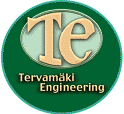|
|
|||||||||||||||||||||||||||||||||
|
|||||||||||||||||||||||||||||||||
| The beauty of the old wooden (motor)gliders!
In
the late sixties three new single-seat motorgliders were developed in
Germany, all of which were similar in basic concept, involving a high
aspect ratio low wooden wing and the engine on the nose. They were the
Schleicher ASK-14, Sportavia RF-4 and Scheibe Flugzeugbau SF-29. At the
time, they inspired me to consider the design of a similar plane but it
never materialized. However, I flew my first ever soaring hours in an
RF-4 and later bought an ASK-14 which I flew for three years. |
|||||||||||||||||||||||||||||||||
| "I saw your photo of the ASK-14
you previously owned. I am currently researching the possibility of
acquiring a set of plans from the factory to begin a homebuilt of that
beautiful craft. Do you know of any earlier gliders of the ASK-14 type
that plans are available for? Can you supply any copies of info, specs,
manuals, etc. for the ASK-14. Would you be interested in drawing up a
set of plans for a homebuilt ASK-14 type craft using modern design
concepts but remaining true to the original in style? Wood is my
material of choice and a cockpit sized for larger pilots. The aircraft
is so beautiful!" Thank you, Bob Babcock |
|||||||||||||||||||||||||||||||||
JT-10 Concept: Something of all the above-mentioned motorgliders is included in the JT-10 concept. It has a steel tube fuselage like the SF-29, a vertical tail style and retractable landing gear like the ASK-14 and an engine cowling resembling the one in RF-4. The engine chosen for the design is the Japanese HKS 700, simply because Ihad already made a 3D-model of it. Actually this engine is too big and powerful for the design; a 35 hp unit would be quite enough. There is an alternative available soon, the Hexadyne Aviation P60. Cockpit
size in the original model was not "for larger pilots". It was of my
size, for pilots about 177 cm tall (5 ft 9 in). However, Bob e-mailed
me again that he is 188 cm. (6'-2'') tall and 113.5 kilos (250 lbs.) in
weight. He was a professional athlete in his youth and built like a
heavyweight wrestler still. |
|||||||||||||||||||||||||||||||||
 |
|||||||||||||||||||||||||||||||||
| Wing Construction: For the lightest weight, wing and tail surfaces should be made of wood. If modern composite construction is considered, the problem is the enormous work required to make the plugs and molds. One possibility is to make simple molds of sheet metal (aluminum) which would allow the use of thin sandwich structure by vacuum bag molding. The final wing would not be as smooth as the wings of modern gliders but hopefully better than wooden wings at least. Another method to be considered could be the Burt Rutan "positive lay up" approach. First make the spar, bond foam panels on the spar and hot wire cut the panels to airfoil shape using suitable metal or plywood templates. The skin lay up, filling and painting require the utmost care, otherwise the wing weight could jump to an unacceptable level. Shown below is one possible wing construction using this method. |
|||||||||||||||||||||||||||||||||
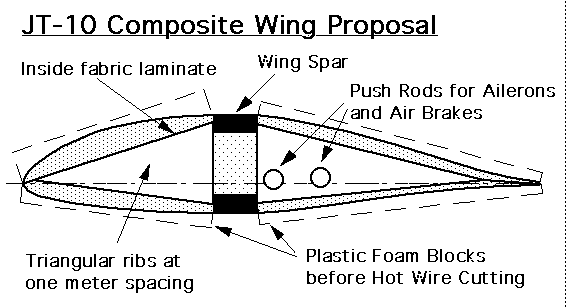 |
|||||||||||||||||||||||||||||||||
|
|
|||||||||||||||||||||||||||||||||
| Landing Gear Variations: A retractable main wheel landing gear combined with retractable outrigger wheels (operated with air brakes) would be my choice for the machine and is shown in the cut away picture above in both gear up and down positions. This necessitates a side stick since there is no space for a central control stick when the gear is retracted. A retractable gear would be OK for a single owner, but in flying clubs with dozens of pilots with varying experience, this type of landing gear combined with a feathering prop would be an expensive combination. I know flying clubs in Finland where belly landings with a RF-4 were so frequent the propeller was practically a disposable item. Therefore, I have modeled three other landing gear alternatives as well; a Scheibe Falke type single wheel, a normal tail wheel type landing gear and a retractable dual wheel type landing gear. All are pictured below: |
|||||||||||||||||||||||||||||||||
| Click the pictures to view the bigger size! | |||||||||||||||||||||||||||||||||
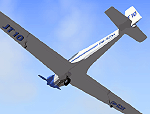 |
|||||||||||||||||||||||||||||||||
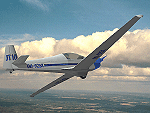 |
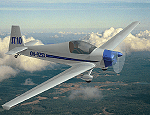 |
||||||||||||||||||||||||||||||||
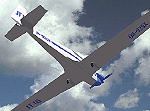 |
|||||||||||||||||||||||||||||||||
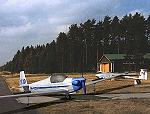 |
|||||||||||||||||||||||||||||||||
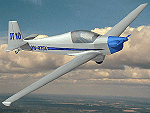 |
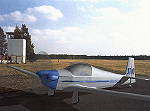 |
||||||||||||||||||||||||||||||||
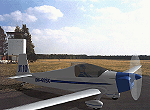 |
|||||||||||||||||||||||||||||||||
| Soaring! The soaring performance of this type of glider is not for the record hunters. Anyway, JT-10 would beat hangliders, paragliders and hot air balloons in penetration regardless of the landing gear configuration and propeller chosen. L/D of 25 could be expected with a retractable gear and feathering prop. I know several glider pilots who only fly local soaring and for them a machine like this would be as good as anything else. In good soaring conditions, one could try to fly a 100 km triangle or even more. The JT-10 model was created and rendered using formZ RenderZone software in a PowerMac computer. |
|||||||||||||||||||||||||||||||||
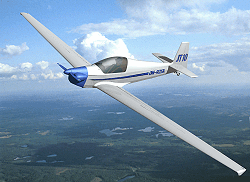 |
|||||||||||||||||||||||||||||||||
|
|
|||||||||||||||||||||||||||||||||
|
Comments: If you have any suggestions or comments regarding this design, please, send me e-mail! Comments: I
would like to encourage you to work further on the JT-10 design. It
would fill a void in the aviation community in this country. I'm a big
believer in the lower powered end of aircraft. Your JT-10 would be a
fun project and a good little flyer. It's unfortunate that the RF4 and
ASK14 never quite caught on in America...hopefully yours' can I
was surfing the web looking for motorglider related topics and came
across your great web site. Your mention of the older wooden single
seat European motorgliders such as the ASK-14, and ,of course, your
JT-10 concept struck me as the PERFECT solution for what I see as a
great need of the sport craft market here in the USA. Is there any
possibility that the JT-10 will be put into production or sold as
detailed plans? What a great combination as a glider/cross
country/touring plane. Well done. Well done. Hueva Paive, Mr Tervamaki, I
recently viewed your web site and saw the article regarding the JT-10
motorglider. I was very excited to see someone else who was interested
in this simpler motorglider. |
|||||||||||||||||||||||||||||||||
